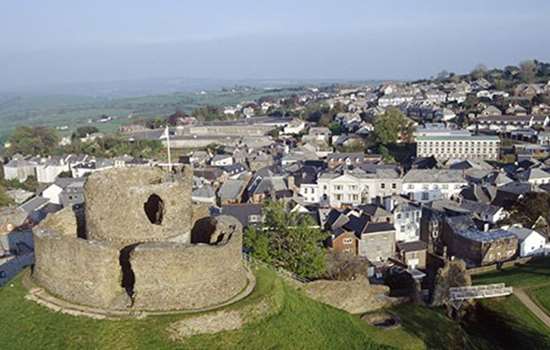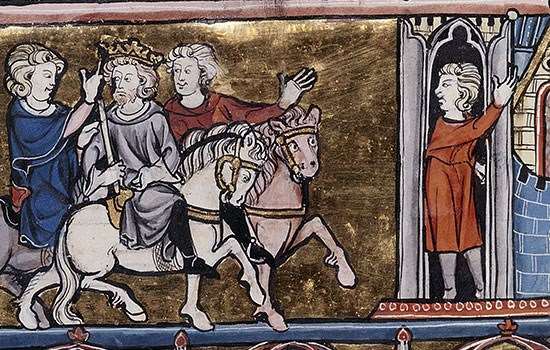The excavated whale bone
The near-complete vertebra is not the only whale bone from the castle. Archaeologists found more than 20 broken vertebrae, rib sections and other small pieces of bone during excavations at the castle between 1961 and 1983. Those that can be securely dated are from the period 1227–1337, when the castle was owned by Henry III’s brother Richard, Earl of Cornwall (1209–72), and his successors.
The distribution of the bones across the site is also of interest. Some came from the outer bailey and north gatehouse, but there was a notable concentration near the kitchen, adjacent to the great hall.
Although we can’t tell which species of whale the bones came from, the size of the large vertebra points to a larger species such as the blue whale, fin whale or sperm whale. This detail is crucial, as whalers of the later medieval period could catch and land smaller whales but not species of this size. It suggests that at least some of the Launceston bones came from a beached whale. We don’t know whether all the whale bone found at Launceston came from just one animal or from several.
The King’s Fish
From the mid 11th century, whale was known as the ‘King’s Fish’ and a portion of each whale caught or found had to be forfeited to the king. According to the English cleric and jurist Henry de Bracton (c.1210–1268), ‘The king owns the head of the whale, the queen owns the tail.’
Although whale was never a major source of food, whale tongue and liver were highly prized delicacies, and other parts of the whale’s flesh were also eaten. As the Launceston whale bone finds can be dated to the period 1227–1337, when whale meat was at its most popular and the castle was owned by Richard, Earl of Cornwall, it is very likely that their presence provides evidence of the lifestyles and exotic diet of the castle’s medieval occupants.
Earl Richard was one of the wealthiest and most powerful men in Europe, having been crowned ‘King of the Romans’ in 1257, a title that identified him as the heir to the Holy Roman Emperor. He spent little time in Launceston, but he is known to have spent Christmas 1259 and his 51st birthday, on 5 January 1260, at the castle. During his visits, or when his family and high-ranking officials were present at the castle, great feasts would have taken place.
Fine dining at Launceston
The excavations at Launceston Castle produced a huge number of animal bones. More than 9,000 of them were identified, providing an insight into the changing diet of the castle’s occupants from the 11th to the 19th century.
Diners at the post-medieval castle appear to have eaten a familiar range of meats, including pork, lamb/mutton and, increasingly, beef. But the evidence suggests that in earlier periods, especially the 11th to 14th centuries, diners enjoyed a lavish and varied diet. In addition to whale, they ate dolphin, fish, and seabirds such as the Manx shearwater, which probably came from a colony on the Isles of Scilly. These foods reflect Launceston’s maritime resources.
Venison was a key part of the diet and some of the meat consumed at Launceston may have come from hunts in the deer park beside the castle. Kid meat (young goat), swan, goose, partridge, woodcock and plover also featured on the late medieval castle’s feasting tables. The privileged inhabitants of Launceston Castle in the 11th to 14th centuries would have enjoyed a diet that was far more varied and exotic than that of their neighbours in the towns and villages of Cornwall.
Nothing wasted
As well as providing an exotic addition to the dining tables of Launceston Castle, a beached whale would have presented the castle’s owners with a number of useful resources.
Whale blubber was a source of oil that could be used in lamps to light the castle. The bone itself could be crafted into everyday items, such as pins for hair and clothing, styli for writing, knife handles, gaming counters and tuning pegs for musical instruments. Although most of the whale bone found at Launceston had not been worked, there is plenty of evidence that antler and bone from other animals was being worked on site.
Large, flat sections of bone such as the whale vertebrae presented other opportunities for reuse without having to be cut and worked. Several of the vertebrae, including the near-complete example, feature parallel cut-marks on their flat surfaces. These marks are not consistent with those left by butchery and suggest that these giant bones may have been reused as chopping boards. As the marks were made by knives, not saws, and the bones were found close to the kitchens, it is likely that they served as kitchen chopping boards rather than as working surfaces for crafting activities.
From princes to prisoners
Launceston’s collection of animal bone helps us to understand the changing lives of the castle’s inhabitants and, in turn, reveals the declining status of the castle itself.
In the late medieval period the castle was a royal residence and important political and economic centre. The Earls of Cornwall and their guests enjoyed lavish feasts that were suited to the tables of England’s elite. But by the post-medieval period the animal bone reveals a more ordinary diet dominated by mutton and beef, befitting the lower status of the castle. By this time it retained only one of its earlier roles – that of county gaol. By the 1650s the castle had been branded ‘Castle Terrible’ and was a far cry from the place of luxury and excess that it had once been.
By Dr Ian Leins
Curator of Collections and Interiors (South West)
Top image: Sailors mistaking a whale for an island, depicted in a 13th-century manuscript
© British Library Board (Harley MS 3244 fol 60v)
Find out more
-

Visit Launceston Castle
Visit the castle to explore its unusual keep, high on a mound, and climb up to the battlements to enjoy impressive views of the town and surrounding landscape.
-

History of Launceston Castle
Find out more about the history of the castle, which for over 600 years was the most important fortress and centre of government in Cornwall.
-

Earl Richard of Cornwall, King Arthur and Tintagel Castle
Discover why the legend of King Arthur led Richard, Earl of Cornwall, to build a castle on an inhospitable rock at Tintagel.
